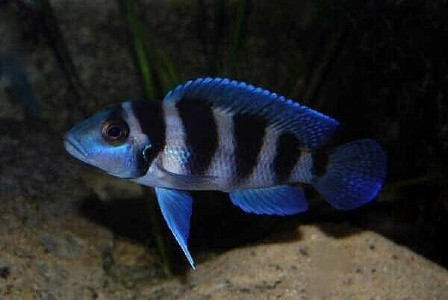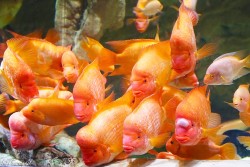Five Bar Cichlid (Neolamprologus tretocephalus) CareSheet
 The Mini Frontosa Cichlid (Neolamprologus tretocephalus), commonly known as the Five Bar Cichlid (despite being unrelated to the Frontosa cichlid), is a tiny to medium rock-dwelling cichlid endemic to Lake Tanganyika in Africa. Because it is more difficult to breed than many other Tanganyikan cichlids, it is significantly less common. It is, nevertheless, a wonderful species that is both resilient and active in the aquarium, as well as having highly stunning and appealing color.
The Mini Frontosa Cichlid (Neolamprologus tretocephalus), commonly known as the Five Bar Cichlid (despite being unrelated to the Frontosa cichlid), is a tiny to medium rock-dwelling cichlid endemic to Lake Tanganyika in Africa. Because it is more difficult to breed than many other Tanganyikan cichlids, it is significantly less common. It is, nevertheless, a wonderful species that is both resilient and active in the aquarium, as well as having highly stunning and appealing color.The Five Bar Cichlid will flourish in an aquarium with lots of open area and stacks of rocks that create caves. The optimum substrate for this species is sand. Mature fish are notoriously hostile, claiming and defending territories around their rock piles and caves. If there is enough room in the tank, this cichlid may be housed alongside other Tanganyikan cichlids that live in different parts of the water column. During spawning, territoriality is at its height, and this species should be kept in tanks with just one male/female pair per tank. The Five Bar Cichlid should not be housed with dwarf shrimp or other tiny, sensitive invertebrates. If spawning is desired, other species should be kept to a minimum or avoided entirely unless the aquarium is large enough with enough of cover and decor.
The uncomplicated Five Bar Cichlid is easy to feed. Dry, freeze dried foods, and live meaty items of high quality will all be welcomed. This species should not be fed dry items entirely since quality and diversity are the keys to a diet that will guarantee that it maintains maximum health and color. It will also benefit from a diet rich in vegetable matter.
Requirements for keeping Neolamprologus tretocephalus
Temperature: 73.4° - 81° F
pH: 7.5 - 9.0
KH: 8 - 25 dKH
Minimum tank size: 40 gallons for an adult pair
Origin: Indigenous to Lake Tanganyika, Africa
Average adult size: 6 inches

Looks like we are out of stock for Neolamprologus tretocephalus.
Click Here to See More Great Items on eBay!FAQ's
What is Neolamprologus tretocephalus?
Neolamprologus tretocephalus is a species of cichlid fish native to Lake Tanganyika in East Africa. It is known for its unique appearance and behavior.
What is the natural habitat of Neolamprologus tretocephalus?
Neolamprologus tretocephalus is typically found in rocky habitats along the shores of Lake Tanganyika, where it seeks shelter among crevices and caves.
What is the size of Neolamprologus tretocephalus?
Adult Neolamprologus tretocephalus can reach sizes of up to 6-7 inches (15-18 cm) in length.
What are the distinctive features of Neolamprologus tretocephalus?
Neolamprologus tretocephalus is known for its elongated body, pointed head, and a unique cranial hump on the forehead, which is more prominent in males.
What is the typical diet of Neolamprologus tretocephalus?
Neolamprologus tretocephalus is omnivorous and primarily feeds on small invertebrates, algae, and zooplankton in its natural habitat.
How do Neolamprologus tretocephalus reproduce?
They are substrate spawners, and the female typically lays eggs in a sheltered location, such as a cave or crevice. The male guards the eggs and fry.
What are the recommended tank conditions for keeping Neolamprologus tretocephalus in captivity?
In captivity, it's essential to replicate their natural habitat. A spacious tank with rocks, caves, and sandy substrate is recommended. Water parameters should mimic Lake Tanganyika conditions: pH around 7.8-9.0, hardness (dH) of 10-20, and a temperature of 75-80°F (24-27°C).
Are Neolamprologus tretocephalus suitable for community tanks?
Due to their territorial nature and aggression, Neolamprologus tretocephalus is best kept in a species-specific tank or with other Tanganyikan cichlids that can tolerate their behavior.
What challenges should I be aware of when keeping Neolamprologus tretocephalus?
Maintaining proper water quality, providing suitable hiding places, and managing their territorial disputes are common challenges when keeping Neolamprologus tretocephalus.
How can I differentiate between male and female Neolamprologus tretocephalus?
Males typically have a more pronounced cranial hump and are larger than females. During the breeding season, males may display more intense colors and markings.
